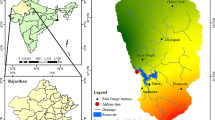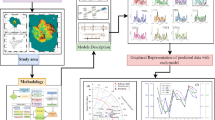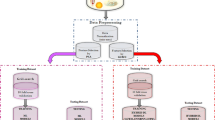Abstract
Multiphase flow through both vertical and horizontal tubulars is getting higher interest in the oil and gas industry. Prediction of wellhead pressure through vertical wells is a very critical point that has a great influence on different applications. In this research, an artificial neural network with backpropagation technique (ANN-BP) was used to predict the wellhead pressure (WHP) for multiphase flow for vertical well systems. This permits the calculation of the pressure drop across the vertical well section by knowing the bottom hole flowing pressure (BHP). More than 150 data sets from different wells in the Middle East with different conditions were used to build the model. About 80% of the data were used to train the model while the rest unseen 20% were used to test and validate the model. The network structure, including the training function, the transfer function, the number of hidden layers, and the number of neurons in each layer, was highly optimized by trying different combinations of each parameter. The developed ANN model yielded high accuracy in predicting the WHP with an average absolute percentage error (AAPE) for both training and testing which are 0.61% and 1.13%, respectively. The optimized model comprised a single hidden layer with 20 neurons activated with the transfer function “tansig.” The correlation coefficient between the actual and predicted values for both training and testing was 0.98. A new empirical equation was then developed to mimic the developed ANN model by extracting the network weights and biases. The developed ANN-based correlation outweighs the previously established correlations in the literature upon comparison using unseen dataset.





Similar content being viewed by others
Abbreviations
- BHP:
-
bottom-hole pressure
- WHP:
-
wellhead pressure
- ESP:
-
electrical submersible pump
- ANN-BP:
-
artificial neural networks with backpropagation technique
- trainlm:
-
Levenberg-Marquardt backpropagation algorithm
- traingda:
-
gradient descent with adaptive learning rate backpropagation
- AAPE:
-
average absolute percentage error
- CC:
-
correlation coefficient
- WH:
-
well-head pressure
- GWO:
-
gray wolves optimization
- GA:
-
genetic algorithm
- PSO:
-
particle swarm optimization
- GLR:
-
gas-liquid ratio
- ID:
-
inner diameter of the pipes
- L:
-
pipe length
References
Agwu OE, Akpabio JU, Alabi SB, Dosunmu A (2018) Artificial intelligence techniques and their applications in drilling fluid engineering: a review. J Pet Sci Eng 167(August):300–315. https://doi.org/10.1016/j.petrol.2018.04.019
Ahmed MM, Ayoub MA (2014) A comprehensive study on the current pressure drop calculation in multiphase vertical wells; current trends and future prospective. J Appl Sci 14:3162–3171
Al-Najjar HSH, Abu Al-Soof NB (1989) Alternative flow-pattern maps can improve pressure-drop calculations of the Aziz et al. multiphase-flow correlation. SPE Prod Eng 4(03):327–334. https://doi.org/10.2118/17263-PA
Amar N, Menad NZ, Redouane K (2018) Bottom hole pressure estimation using hybridization neural networks and grey wolves optimization. Petroleum 4(4):419–429. https://doi.org/10.1016/j.petlm.2018.03.013
Asheim H (1986) MONA, An accurate two-phase well flow model based on phase slippage. SPE Prod Eng 1(03):221–230. https://doi.org/10.2118/12989-PA
Aziz K, Govier GW (1972) Pressure drop in wells producing oil and gas. J Can Pet Technol 11(03). https://doi.org/10.2118/72-03-04
Baxendell PB, Thomas R (1961) The calculation of pressure gradients in high-rate flowing wells. J Pet Technol 13(10):1,023–1,028. https://doi.org/10.2118/2-PA
Beggs DH, Brill JP (1973) A study of two-phase flow in inclined pipes. J Pet Technol 25(05):607–617. https://doi.org/10.2118/4007-PA
Brill JP, Mukherjee H (1999) Multiphase flow in wells. Monograph series, vol 17. SPE, Richardson, Texas, pp 2–69
Buscema M (1998) Back propagation neural networks. Subst Use Misuse 33(2):233–270. https://doi.org/10.3109/10826089809115863
Demuth H, Beale M, Hagan M (2016) Neural network ToolboxTM 6:901
Duns H Jr, Ros NCJ (1963) Vertical flow of gas and liquid mixtures in wells. World Petroleum Congress
Eaton BA, Knowles CR, Silberbrg IH (1967) The prediction of flow patterns, liquid holdup and pressure losses occurring during continuous two-phase flow in horizontal pipelines. J Pet Technol 19(06):815–828. https://doi.org/10.2118/1525-PA
Faghri A, Zhang Y (2006) Introduction to transport phenomena. In: Transport Phenomena in Multiphase Systems. Academic Press, Boston, pp 1–106. https://doi.org/10.1016/B978-0-12-370610-2.50006-4
Fancher GH Jr, Brown KE (1963) Prediction of pressure gradients for multiphase flow in tubing. Soc Pet Eng J 3(01):59–69. https://doi.org/10.2118/440-PA
Gloss D, Herwig H (2010) wall roughness effects in laminar flows: an often ignored though significant issue. Exp Fluids 49(2):461–470. https://doi.org/10.1007/s00348-009-0811-6
Hagedorn AR, Brown KE (1965) Experimental study of pressure gradients occurring during continuous two-phase flow in small-diameter vertical conduits. J Pet Technol 17(04):475–484. https://doi.org/10.2118/940-PA
He G, Li Y, Wang B, Lin M, Liang Y (2018) Gas-Liquid Stratified Flow in Pipeline with Phase Change. Heat Transfer - Models, Methods and Applications. https://doi.org/10.5772/intechopen.74102
Hecht-nielsen R (1992) Theory of the backpropagation neural network**Based on ‘Nonindent. In: Neural Networks for Perception. Academic Press, pp 65–93. https://doi.org/10.1016/B978-0-12-741252-8.50010-8
Jahanandish I, Salimifard B, Jalalifar H (2011) Predicting bottomhole pressure in vertical multiphase flowing wells using artificial neural networks. J Pet Sci Eng 75(3):336–342. https://doi.org/10.1016/j.petrol.2010.11.019
Kinate BB, Dune KK, Kluivert N-b L (2018) Optimum tubing size prediction for vertical multiphase flow in Niger Delta wells. International Journal of Scientific and Engineering Research 9(2):13
Kişi Ö, Uncuoğlu E (2005) Comparison of three back-propagation training algorithms for two case studies. Indian Journal of Engineering and Materials Sciences 12(5) October. http://nopr.niscair.res.in/handle/123456789/8460
Mohammadpoor M, Shahbazi K, Torabi F, Firouz ARQ (2010) A new methodology for prediction of bottomhole flowing pressure in vertical multiphase flow in Iranian oil fields using artificial neural networks (ANNs). In: Society of Petroleum Engineers SPE Latin American and Caribbean Petroleum Engineering Conference, 1-3 December. Peru, Lima. https://doi.org/10.2118/139147-MS
Mukherjee H, Brill JP (1985) Pressure drop correlations for inclined two-phase flow. J Energy Resour Technol 107(4):549–554. https://doi.org/10.1115/1.3231233
Okon A, Appah D (2016) Neutral network models for predicting wellhead pressure-flow rate relationship for Niger Delta oil wells. Journal of Scientific Research and Reports 12(1):1–14. https://doi.org/10.9734/JSRR/2016/28715
Olufemi A, Olugbenga F (2008) Predictive tool for bottom-hole pressure in multiphase flowing wells. Petroleum & Coal 50(3):67–73
Orkiszewski J (1967) Predicting two-phase pressure drops in vertical pipe. J Pet Technol 19(06):829–838. https://doi.org/10.2118/1546-PA
Osman E-SA (2001) Artificial neural networks models for identifying flow regimes and predicting liquid holdup in horizontal multiphase flow. Society of Petroleum Engineers 19(1). https://doi.org/10.2118/68219-MS
Osman E-S, Ayoub M, Aggour M (2005) Artificial neural network model for predicting bottomhole flowing pressure in vertical multiphase flow. In: Proceedings of SPE Middle East Oil and Gas Show and Conference Society of Petroleum Engineers. https://doi.org/10.2523/93632-MS
Pat N (2017) Neural Networks and Deep Learning: Deep Learning Explained to Your Granny—A Visual Introduction for Beginners Who Want to Make Their Own Deep Learning Neural Network
Poettman FH, Carpenter PG (1952) The multiphase flow of gas, oil, and water through vertical flow strings with application to the design of gas-lift installations. American Petroleum Institute , Drilling and Production Practice, 1 January, New York
Ruiz R, Brito A, Marquez J (2014) Evaluation of multiphase flow models to predict pressure gradient in vertical pipes with highly viscous liquids. In: Society of Petroleum Engineers SPE Latin America and Caribbean Petroleum Engineering Conference, 21-23 May, Maracaibo, Venezuela. https://doi.org/10.2118/169328-MS
Saeb MB, Philip DM, David CC, Ali J (2015) Modeling friction factor in pipeline flow using a GMDH-type neural network. Cogent Eng 2
Saputelli L, Malki H, Canelon J, Nikolaou M (2002) A critical overview of artificial neural network applications in the context of continuous oil field optimization. In: Society of Petroleum Engineers SPE Annual Technical Conference and Exhibition, 29 September-2 October, San Antonio, Texas. https://doi.org/10.2118/77703-MS
Sprinthall RC, Fisk ST (1990) Basic statistical analysis. Prentice Hall, Englewood Cliffs, NJ
Takacs G (2001) Considerations on the selection of an optimum vertical multiphase pressure drop prediction model for oil wells. In: Society of Petroleum Engineers SPE/ICoTA Coiled Tubing Roundtable, 7-8 March. Texas, Houston. https://doi.org/10.2118/68361-MS
Ternyik J, Iv H, Bilgesu I, Mohaghegh S (1995) Virtual measurement in pipes: part 2-liquid holdup and flow pattern correlations. In: Society of Petroleum Engineers SPE Eastern Regional Meeting, 18-20 September. West Virginia, Morgantown. https://doi.org/10.2118/30976-MS
Zhang G, Eddy Patuwo B, Michael YH (1998) Forecasting with artificial neural networks: the state of the art. Int J Forecast 14(1):35–62. https://doi.org/10.1016/S0169-2070(97)00044-7
Author information
Authors and Affiliations
Corresponding author
Ethics declarations
Conflict of interest
The authors declare no competing interests.
Additional information
Responsible Editor: Santanu Banerjee
Appendix
Appendix
The developed ANN-based model was validated by comparing its results and those obtained from the previously published correlations listed in the following table. Pressure drop was calculated based on these correlations and then subtracted from the bottom hole pressure to produce the final wellhead pressure. These empirical correlations defined the total pressure drop gradients \( {\left(\frac{dp}{dl}\right)}_t \) as the summation of three different components as follows, Eq. (6);
where \( {\left(\frac{dp}{dl}\right)}_f \) is the pressure drop gradient due to friction, \( {\left(\frac{dp}{dl}\right)}_h \) is the pressure drop gradient due to hydrostatic head, and \( {\left(\frac{dp}{dl}\right)}_a \) is the pressure drop gradient due acceleration.
Both the hydrostatic pressure drop term and the acceleration term can be defined as general terms for all correlations and can be calculated by the following Eqs. (7) and (8).;
where ρ is the fluid density, g is the gravity acceleration, θ is the inclination angle with respect to the vertical direction, v is the fluid velocity, and l is the pipe length.
The pressure drop gradient due to friction varies from one correlation to another. A summary of pressure drop gradient due to friction of each used correlation is shown in Table (3).
Rights and permissions
About this article
Cite this article
Gomaa, I., Gowida, A., Elkatatny, S. et al. The prediction of wellhead pressure for multiphase flow of vertical wells using artificial neural networks. Arab J Geosci 14, 795 (2021). https://doi.org/10.1007/s12517-021-07099-y
Received:
Accepted:
Published:
DOI: https://doi.org/10.1007/s12517-021-07099-y




